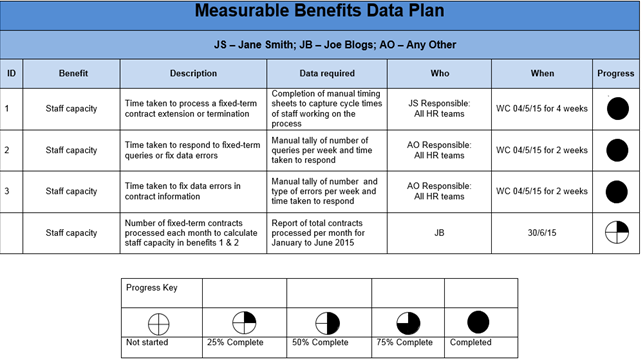I’ve recently been discussing the Benefits Exploration Map with Continuous Improvement colleagues at Brunel University London and the University of Hertfordshire, and following their insightful feedback on using the tool, I’d like to share further best practice on how you can continue to engage people with evidencing benefits by linking the Benefits Exploration Map to the Measurable Benefits Data Plan.
The BI Team at Strathclyde have been using the Benefits Exploration Map in our projects since the beginning of 2015. But what happens next? How do you engage people to take this forward and ensure that the potential benefits that they have identified are regularly reviewed, and become fully realised benefits that demonstrate the impact of their project?
The tool you need is the Measurable Benefits Data Plan.
Taking ownership
Simply put, the Measurable Benefits Data Plan drives the data capture required to evidence project benefits and encourages every project team member to take ownership of this activity. At Strathclyde, the Fixed-Term Contract Project Team used this tool with great success to capture the baseline data for their project benefits.

One of the most important steps when using the Data Plan is to look at each measurable benefit identified on the Benefits Exploration Map in more detail, to consider what exactly is going to be measured. A good example to illustrate this point is staff capacity savings.
This was identified for the Fixed-Term Contract project as a single measurable benefit on the Exploration Map, yet when the project team thought about this further, they realised that there were actually four aspects to staff capacity saving that required baseline data.
These were:
- the time it takes for those working on the process to complete their process steps,
- the time it takes to respond to queries about contracts and to fix errors in the contract information and
- the total number of contracts that are processed each month.

The Measurable Benefits Data Plan allows you to break the benefits down in this way and document exactly what needs to be measured; making the activity clear, transparent and achievable. Furthermore, the tool is also helpful in coordinating who is responsible for capturing the data and when this is going to be completed. In the Fixed-Term Contract project the baseline data was captured over a period of two months, and the team used the Data Plan to make sure they did not misinterpret or forget what needed to be recorded or who was doing it.
In the coming months the project team will use the very same Measurable Benefits Data Plan to drive the measurement of post-improvement data, which when combined with the baseline data will provide robust evidence of where staff capacity savings have been made.
I hope my example above demonstrates how this tool can be used to progress from the identification of all the potential project benefits, to actively capturing the data required to evidence the measurable benefits.
For more information on how to enhance the evidencing of benefits and gathering of baseline data, please see our Guide which contains all the necessary tools and templates, including the Measurable Benefits Data Plan.


